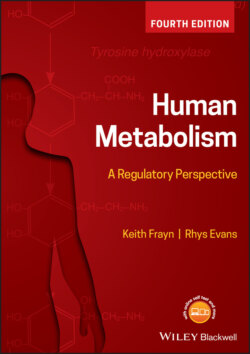Читать книгу Human Metabolism - Keith N. Frayn - Страница 25
Box 1.4 Anabolism and catabolism
ОглавлениеThe terms anabolism and catabolism are useful but can be confusing and have frequently been misused. They should be used to refer to whole-body energy strategy:
Hence, in the postprandial state, after a meal, we are entering an anabolic state, whereas in the post-absorptive state, following absorption and disposition of the meal, we are entering a catabolic state. This is signalled by insulin.
Classic physiological catabolic states include fasting/starvation (decreased energy intake) and exercise (increased energy expenditure). Diabetes mellitus is an example of a pathological catabolic state (failure of insulin signalling).
If the terms are applied to individual metabolic pathways, or even individual steps, confusion can arise. For example glycolysis may be thought of as ‘catabolic’ in exercising muscle, breaking down glucose to provide energy for contraction (net energy mobilisation), but ‘anabolic’ in liver in the well-fed postprandial state, when absorbed glucose is converted to pyruvate, but the resulting acetyl-CoA undergoes lipogenesis to fat for energy storage. When analysing metabolism it is important to consider the whole body (anabolic? catabolic?) as well as individual tissues, as these all have specialised metabolic profiles and functions (see Chapter 5).
The body is subject to many catabolic signals (e.g. ‘stress hormones,’ catecholamines, glucocorticoids, glucagon etc., but one major anabolic signal – insulin. Insulin inhibits catabolism, and therefore when it declines, unopposed catabolism results. This is one rea- son why insulin is such a crucial signal, and diabetes such an important disease.
The rate of energy production is measured under basal conditions (no voluntary muscle contraction; thermoneutrality) – ‘basal metabolic rate’ (BMR), and is affected by many factors, including muscle contraction, food ingestion, size, gender, age, temperature, sepsis, and several hormones, including thyroid hormones and catecholamines. The metabolic rate can be estimated by measuring the oxygen consumption (VO2; indirect calorimetry). For carbohydrate metabolism the rate of CO2 production (VCO2) equals VO2 (C6H12O6 + 6O2 → 6CO2 + 6H2O) and the ratio VCO2/VO2, termed the respiratory quotient (RQ), is 6/6 = 1. For lipid oxidation, however, this is not true (e.g. tripalmitin: 2C51H98O6 + 145O2 → 102CO2 + 98H2O; RQ = 102/145 = 0.70) and measurement of RQ can provide useful information on substrate selection and utilisation. This will be discussed further in Chapter 11 (Box 11.2).
